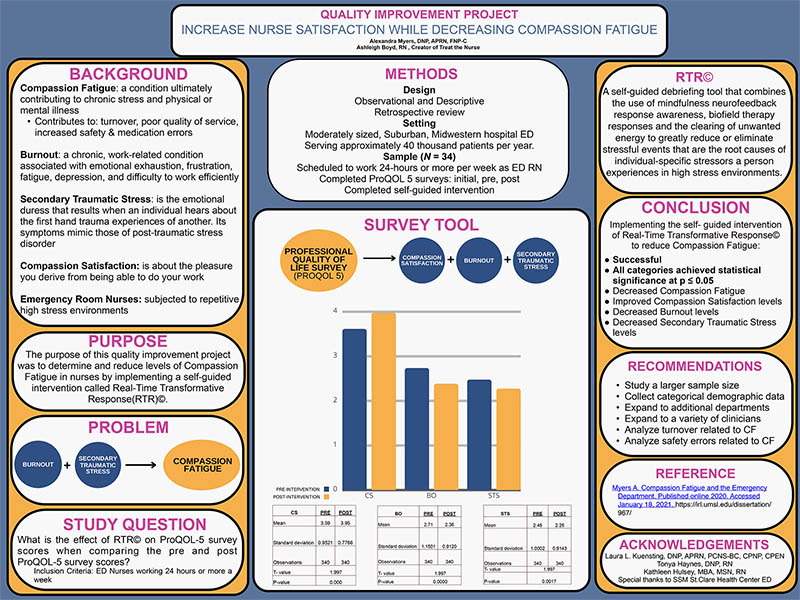
Hover to pan and click to magnify. Click again to pan at full screen.
Ashleigh Boyd, RN
Alexandra Myers, DNP, APRN, FNP-C
Ashleigh Boyd, RN
Alexandra Myers, DNP, APRN, FNP-C
SSM Health
St. Clare Health Center Emergency Department
ABSTRACT
Background The purpose of this quality improvement project was to identify and reduce the level of Compassion Fatigue(CF) in Emergency Department nurses by implementing a self-guided intervention. CF was the largest concern for nurse vacancy rates by administration and confirmed that ED Nurses were in the moderate risk category CF via Professional Quality of Life (ProQOL-5) survey results.
Method A Plan Do Study Act method of quality improvement was used for this project. The self-guided intervention of Real-Time Transformative Response© (RTR©) was used The (ProQOL-5) was used to measure and determine if it was effective in reducing levels of CF in ED Nurses.
Intervention The RTR© method is used to greatly reduce or eliminate stressful events that are the root causes of a person's specific stressors. RTR© was distributed to ED Nurses via a three part, self-guided, video educational series. ED Nurses were surveyed pre-RTR© and post.-RTR© intervention to determine the effectiveness of the method.
Results 34 ED nurses (N=34) completed RTR© training and ProQOL-5 surveys. The overall mean score for the pre-RTR© training survey was 107 (sd =1.1385), and the post-RTR© training survey was 106.613 (sd =1.1677) (t =1.6924, df =66, p =0.0476). Mean scores pre-and post-RTR© training: compassion satisfaction was 3.59 (sd = 0.9521) increased to 3.95 (sd = 0.7766) (t = 1.997, df = 66, p = 0.000), burnout was 2.71 (sd = 1.1501) decreased to 2.36 (sd = 0.9120) (t = 1.997, df = 66, p = 0.000), and secondary traumatic stress was 2.45 (sd = 1.0002) decreased to 2.25 (sd = 0.9143) (t = 1.997, df = 66, p = 0.0017).
Conclusions Increasing compassion satisfaction and having an overall decrease in CF, BO, STS from using the self-guided RTR© methods concluded that it is a valid coping mechanism for Nurses.

DISQUS COMMENTS WILL BE SHOWN ONLY WHEN YOUR SITE IS ONLINE